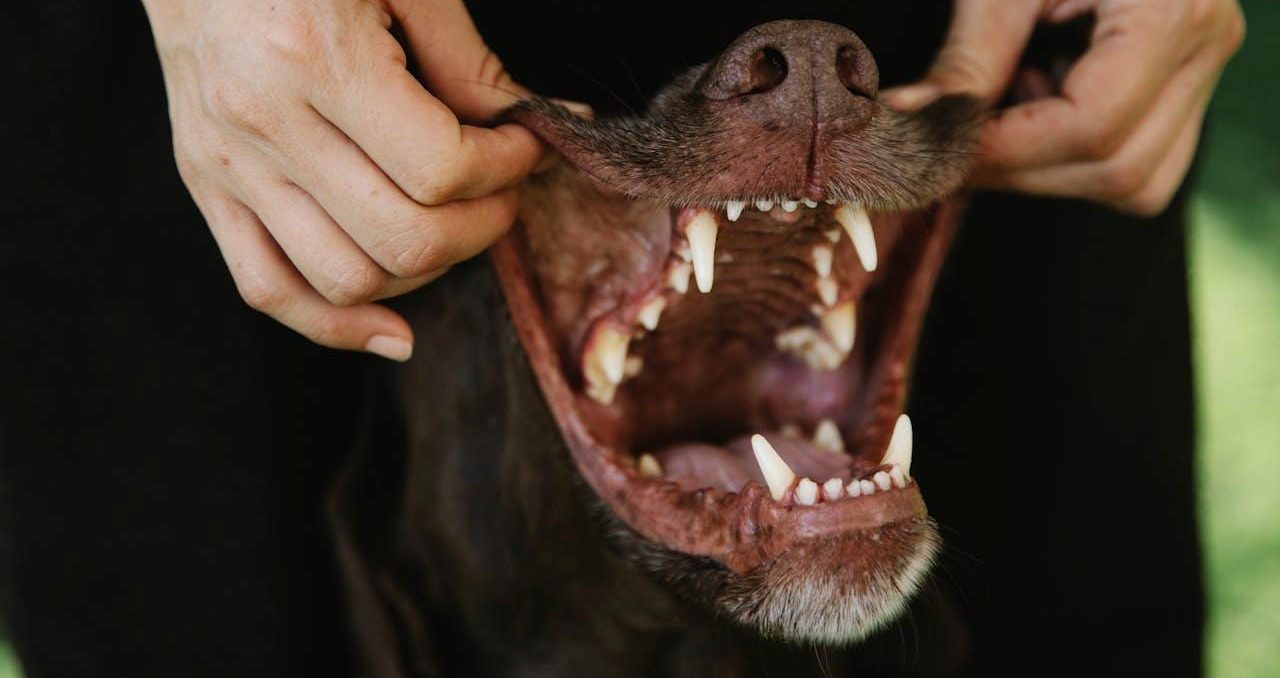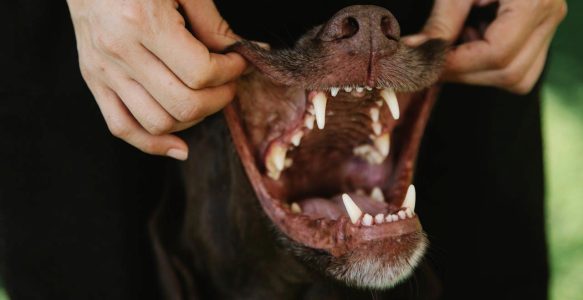Excited for puppy kisses but turned off by that pungent doggy breath? Dental disease is the most common cause for bad breath in dogs! It is also one of the most commonly diagnosed disease in the veterinary hospital with over 80% of dogs having dental disease by age 3.
When left untreated, dental disease can be a continuous source of pain and inflammation, but can also contribute to heart, lung and kidney diseases. Fortunately, it is a preventable condition, meaning there are lots of options you can try at home to protect your canine companion’s oral health.
This article delves what dental disease is, what causes it, how it’s treated and what steps you can take to prevent it from home!
Contents
•What is Dental Disease?
•What Breeds are Prone to Dental Disease?
•Signs of Dental Disease
•Diagnosis of Dental Disease
•Treatment of Dental Disease
•Prevention of Dental Disease
•Toothbrushing
•Dental Diets
•Dental Treats
•Food Water Additives
•Fractured and Chipped Teeth
•Frequently Asked Questions
What is Dental Disease?
The term dental disease generally refers to any inflammation, infection or lesions within the mouth, especially involving the teeth. The most commonly seen dental disease in dogs is periodontal disease and fractures. Periodontal disease starts with plaque and tartar but can progressively get worse and affect deeper structures of the tooth.
Plaque is the result of bacteria in the mouth. Over the course of the day, bacteria builds up on the teeth and produces a protective film called biofilm. Some plaque is naturally removed during the day with some dry food or chews helping scrape the tooth surface to remove plaque.
Calculus or Tartar is used to describe plaque that has become hardened. Plaque must be removed when it is soft, usually within 3 days. Plaque hardens by absorbing the minerals in saliva and the gingiva (gums). Tartar has a rough surface, which is perfect for more plaque to stick to.
Gingivitis is the inflammation of the gums as a result of plaque and bacteria build up. The gumline will become red, swollen and painful as the immune system responds to the plaque build up. This is an early sign of dental disease and the only stage that can be treated.
Gingivitis can also be the result of systemic diseases such as Kidney Disease and Diabetes.
Periodontitis, or periodontal disease, is a deeper infection of the gums. When plaque and gingivitis are left untreated, the bacteria can penetrate beneath the gumline, where they can damage the underlying tissues. The tissues that can be damaged by this progression include the gumline itself, the periodontal ligament that holds the tooth root to the bone, the cementum that covers and protects the tooth root’s surface and the bone surrounding the tooth root. This damage is severe and irreversible and can lead to the teeth falling out.
The loss of bone associated with periodontal disease can lead to other secondary health concerns, including oro-nasal fistulas (a hole between the mouth and nose), fractures of the jaw, and abscess formation, which may drain in to the mouth, under the chin, or from the face (often under or behind the eyes). The bacteria from periodontitis can also access the bloodstream and travel to other organs, such as the heart, liver and kidneys, where it causes further damage.
What Breeds are Prone to Dental Disease?
Small dog breeds are more likely to experience dental disease. This is because their teeth, the same number as a large dog, tend to be cramped in a smaller mouth, with less gap between them for natural tooth cleaning. Small breeds also tend to be more prone to alignment abnormalities like an overbite or underbite, which interferes with normal function of the jaw. This is especially true for the toy breeds like Chihuahuas, Yorkshire Terriers, Poodles and Maltese breeds. Brachycephalic, or flat-faced, dogs are another category that is prone to dental disease, again due to their teeth being cramped and their predisposition for mal-alignment of the jaw.
Sighthounds, like Greyhounds and Whippets are also very prone to dental disease. Their long, narrow snout can contribute to overcrowding of teeth, creating a predisposition for dental disease. Other long snouted dogs, like Dachshunds and Collies are also prone to dental disease as their long snouts can make them prone to periodontal pockets (gaps between tooth and gum) where bacteria can build up. Collies are also prone to an overbite, increasing their risk of dental disease.
Border Collies can have a genetic condition called Dental Hypomineralisation which can make their teeth weak and prone to dental disease. Meanwhile, Boxers, Great Danes, Collies and Mastiffs can be susceptible to Gingival Hyperplasia which is an overgrowth of the tissue in the gums.
Signs of Dental Disease
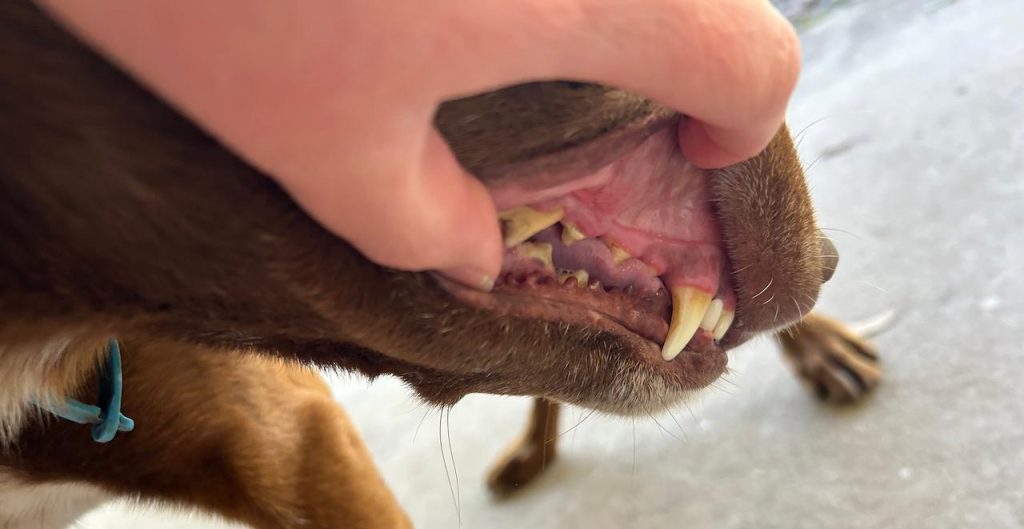
A variety of signs of dental disease can present in dogs, depending on the type of disease present and the severity of disease. However, the signs may be subtle or non-specific. If you notice any signs of dental disease in your dog, it is best to get the examined by a veterinarian promptly.
- Signs of dental disease can include:
- Excessive drooling
- Blood in the saliva
- Yellow/brown tartar/staining on the teeth
- Bad breath (Halitosis)
- Pawing at the mouth
- Head shaking
- Jaw chattering
- Reluctance to eat
- Swallowing food whole
- Chewing with discomfort or on one side
- Redness around the gums
- Dropping food
- Reduced grooming
- Unkempt coat
- Finicky eating (refusing dry food or preference for wet/soft food)
- Diffficulty swallowing
- Weight loss
- Tooth loss
- Pink lesions on the tooth (especially along the gum line)
Diagnosis of Dental Disease
While pet parents may notice the first signs of dental disease at home, dental disease is most commonly picked up in the veterinary clinic during routine examination. Vets will notice plaque, tartar, gum recession or gingivitis indicating dental disease. At this stage, they may be able to make some assessment as to the severity of the dental disease and advise management going forward. While the full extent of the dental disease often cannot be determined until your pup is under a general anaesthetic and dental x-rays can be taken, your vet should be able to get an idea of the possible severity and quote the likely cost of a dental procedure.
Treatment of Dental Disease
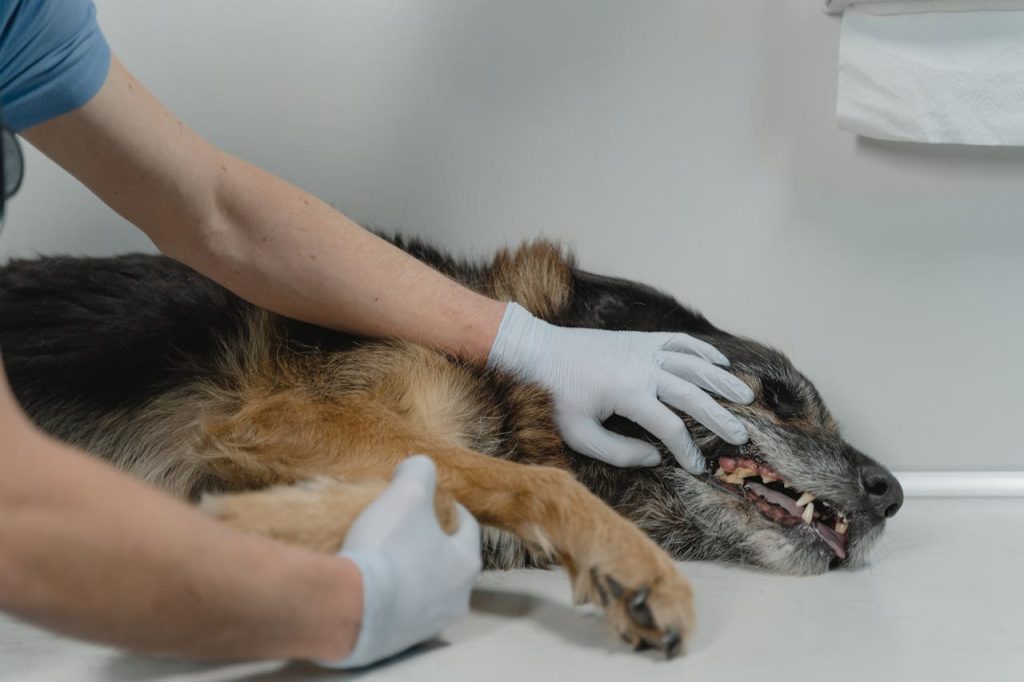
The treatment of dental disease can vary by the type of disease present and the severity. Early gingivitis and plaque may be able to be managed with daily tooth brushing, antibiotics or oral rinses at home. However, once tartar or deeper dental disease has developed, this will need to be professionally removed by a vet.
For our pets, this will involve a general anaesthetic with a scale and polish. The scale process removes plaque and tartar from the teeth. The polishing process may assist in removing staining, while also preventing dental disease from returning.
While your dog is under anaesthesia, the vet will also look for signs of more severe underlying dental disease. This will involve looking for loose teeth, probing the gum for recession and periodontal pockets, and potentially taking x-rays to assess the health of the roots of the teeth. These signs may indicate the need for tooth removal, which will be undertaken while your pet is asleep.
Often teeth with periodontitis will require extraction due to the damage to the underlying tissues, including the bone and tooth root.
Prevention of Dental Disease
Prevention is better than a cure!
You can start your dog’s dental care while they are still a puppy and make it into a part of your daily routine. Doing this protects the teeth right from the start, offering them a longer, healthier life. While it is easier to teach your puppy how to have their teeth brushed while they are eager to learn, there’s nothing stopping you from teaching an older dog some new tricks. If you haven’t started with your puppy, then now is a perfect time to start. For dogs with existing dental disease, a scale and polish is a great way to provide a clean slate to start from.
Whenever you are looking for preventatives, try to look for products with the Veterinary Oral Health Council (VOHC) approval stamp on them. The VOHC is a board of veterinarians and dentists who set the criteria for dental products for the pet market in order to determine if they achieve the claims they make. Only products that can prove they achieve the standards set out by the VOHC can be approved. The stamp is shown here:
A full list of the VOHC approved products for dogs can be found at: https://vohc.org/accepted-products/
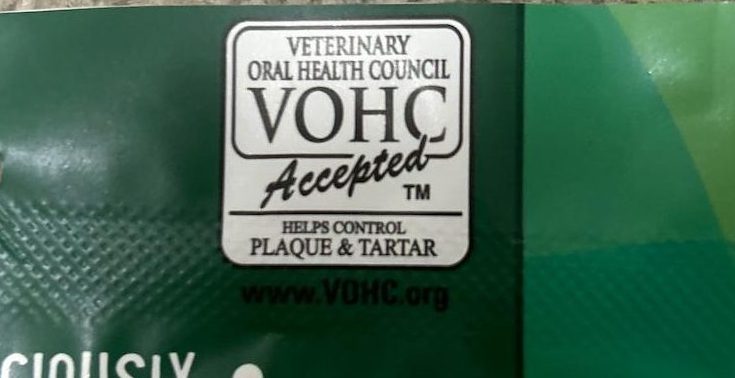
Here are 4 tricks you can implement at home to help prevent dental disease in your dog:
1. Toothbrushing

Fun Fact: Toothbrushing’s effectiveness was tested in Beagles before it was recommended for use in people! That means we know toothbrushing is the most effective way of keeping the teeth free from plaque and tartar. It does take a little bit of training to get your dog comfortable with the process. Start out slow and only for short sessions to allow them to get used to the sensation of brushing, as well as the taste of the toothpaste, and don’t forget to reward them afterwards with a little bit of food (or a dental treat!).
It is recommended to brush your dog’s teeth daily, however, even just 2-3 times a week can be of benefit. Plaque that remains on the teeth for longer than 3 days will harden into calculus, which is harder to remove. If toothbrushing isn’t accepted, at least try to rub the teeth with some gauze or a tooth wipe every 2-3 days to prevent calculus formation.
Be sure to use a dog appropriate toothbrush and toothpaste. Human products are not suitable, with brushes potentially causing pain and human toothpastes being toxic to dogs. A finger brush or specially angled pet toothbrush are both great options for dogs. They are softer and designed specifically to suit the shape of your dog’s teeth, making it more comfortable in their mouths. Many dog toothpastes have a chicken flavour to make the process more pleasant for them. Petsmile is an example of a VOHC approved toothpaste that comes in some great flavours like Rotisserie Chicken or Cheese.
2. Therapeutic Dental Diet
Don’t worry if you can’t get your dog to accept toothbrushing. There have been a lot of advances in the field of animal nutrition and nutraceuticals. This means there is a wide range of products on the market that are designed to remove plaque and prevent tartar, including everyday diets. There are two types of diets available on the market; prescription diets and oral care diets.
Prescription diets are those from Hills Prescription Diet and Royal Canin Veterinary. These diets are specially formulated to plaque and tartar build up, while being nutritionally balanced and complete for use as a sole diet source and containing additional nutritional benefits. Prescription diets are usually recommended for pets with a history of dental disease, or those who are at an increased risk. These diets are VOHC approved.
Oral Care Diets are over-the-counter retail diets with added ingredients to benefit dental health. These diets are nutritionally balanced and complete for long term feeding and can be used as a standalone diet or alongside an alternative food. These diets are best suited to pets just looking to prevent dental disease. The top recommended brands include Hills Science Diet (VOHC Approved), Royal Canin, Advance and Black Hawk. It is also worth noting that the 3-D Dentadefence design in Eukanuba adult maintenance dry foods has approval by the VOHC for tartar prevention.
Diets and dental chews generally employ two types of cleaning methods to prevent dental disease; mechanical and chemical. Mechanical cleaning is anything that physically scrapes or “brushes” the teeth to remove plaque. Chemical cleaning involves the use or targeted active ingredients that prevent plaque or tartar formation.
To look for dental benefits in a food, look for the following characteristics:
- Kibble Shape/Texture: Kibble designed to support dental disease is typically designed with a specific shape or texture that allows the teeth to sink into the kibble piece during chewing. This allows the kibble matrix to “brush” the tooth surface during the chewing process, rather than breaking apart quickly and crumbling like most kibble. This is a mechanical form of cleaning the teeth.
- Sodium Tripolyphosphate/Pentasodium Triphosphate: This ingredient is often included in toothpaste, as well as dental dry foods. It is a whitening agent, assisting in preventing and removing yellow staining of the teeth. It also has the ability to bind minerals in the saliva, such as Calcium, which contribute to calculus formation, to aid in preventing it from forming.
- Zinc Salts: Zinc salts, often bound as ascorbate and gluconate, interfere with the mechanisms of function within bacteria. This decreases the reproduction of the bacteria and the release of sulphates from bacteria, which can be responsible for foul-smelling doggy breath. Zinc Ascorbate can promote collagen production to assist in repairing damaged tissues. Zinc Gluconate inhibits plaque maturation and calculus formation.
- Vitamin C: Vitamin C is a well-known anti-oxidant that has also been shown to strengthen the gums via the periodontal ligament. It is typically used in combination with Zinc Sulfide products and foods or treats containing this combination are more effective at preventing dental bacteria. Combined with Zinc, it also has some mineral binding properties to reduce tartar production. Zinc Ascorbate is the bound form of a Zinc salt and Vitamin C (Ascorbic Acid). Vitamin C can also be combined with Lactic Acid for similar effects to Zinc combinations.
3. Dental Treats
Dental treats are a great option for helping to prevent dental disease in dogs. There are a wide variety of treats available to suit your individual dog’s preferences. Dental treats work through similar methods to dental dry foods, by using the mechanical action of scraping against the teeth during chewing to remove plaque that may have built up over the course of the day. They are treats though, so be carefully not to give too many and account for them as part of your dog’s daily intake to avoid any excess weight gain.
There is a wide range of VOHC approved dental treats, including Greenies, Whimzees, OraVet Chews and Veggiedent Chews. The great news is that Whimzees are a vegetable based treat and very low in fat, meaning they are also a great option for pets with Pancreatitis.
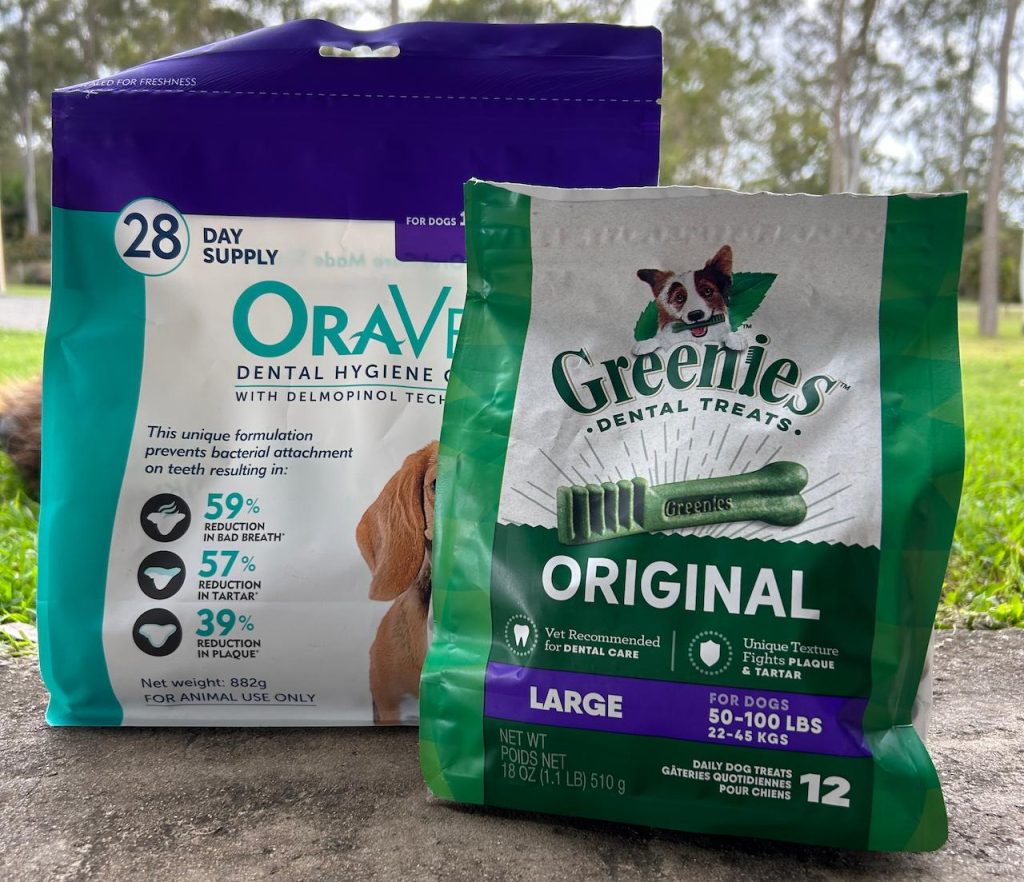
4. Water or Food Additives
Alongside edible preventatives, there are also a wide variety of water and food additives available to prevent or reduce dental disease. It is important to follow the dose carefully for the product to be effective, especially when diluting it in water.
Many of these products on their own are not sufficient to control plaque, and instead should be used alongside some of the above dental care options. They tend to assist with managing the symptoms of dental disease, particularly bad breath, rather than curing it. In saying that, some VOHC approved products are suitable for reducing plaque and tartar, like the PlaqueOff Powder.
In addition to the ingredients listed above, treats, food and water additives may contain these active ingredients:
- Green Tea: Green tea extract contains compounds that can prevent the formation of bacterial biofilm, slowing the growth of bacteria and reducing bad breath odour. It is believed to be able to reduce bacteria by up to 60%.
- Chlorhexidine: Chlorhexidine is a well-known antibacterial, anti-fungal and anti-viral product used in the medical field. It is typically included in oral sprays, washes or gels and plays a valuable role in killing oral bacterial and reducing gingivitis. It also clings to teeth, providing a prolonged effect. However, when applied regularly over a long period of time it may lead to staining of the teeth that requires polishing to remove.
- Enzymes: Some chews and washes contain enzymes to act within the mouth and prevent dental disease. Glucose oxidase is the most common enzyme used and is broken down to hydrogen peroxide. Hydrogen peroxide has antibacterial properties, and used as a fuel for the enzyme lactoperoxidase, which is secreted in the saliva as a natural anti-bacterial.
5. Dental Toys
In addition to the above preventatives, there are also a large variety of dental toys and inedible chews available for dogs. These are often rubber or nylon toys designed with a textured surface to mechanically brush the teeth while your dog is chewing on them, similar to a toothbrush. They are an excellent option for dogs that don’t adapt well to brushing, but love to chew on things. Some dental toys are also designed specifically to relieve teething pain in puppies or to have treats added to them for increased engagement.
Similar to food and water additives, dental toys should for one piece of the dental care plan. They are most effective when combined with products with proven benefits, like toothbrushing and dental diets.
Fractured and Chipped Teeth

Alongside Periodontal disease, the second most common reason for dental problems in dogs is fractured or chipped teeth. Dogs have a love of chewing that puts them at high risk for broken or chipped teeth.
A chipped tooth generally only has surface damage that exposes the dentin beneath the enamel. Dentin is more sensitive, which can lead to oral pain.
A fractured or broken tooth is damaged in a way that exposes the pulp. The exposed pulp contains nerves and blood vessels, so it is very sensitive and vulnerable to oral bacteria, which can travel into other organs in the body, such as the heart, kidneys and liver where they could potentially cause irreparable damage. A tooth with exposed pulp will die after 3 days of exposure and the only solution is extraction of the tooth.
A veterinary dentist may be able to seal chipped or fractured teeth (within 3 days), however, these options are typically not available in general practice, so your vet will opt to remove damaged teeth instead and eliminate your dog’s pain.
Frequently Asked Questions
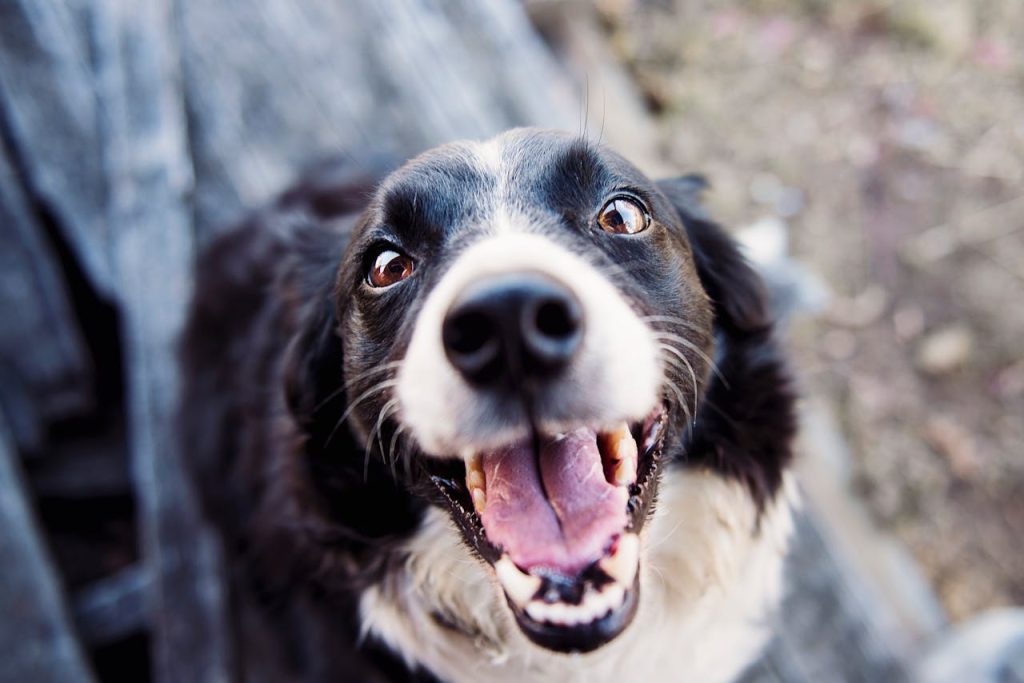
How Do Dogs Chip and Fracture Teeth?
The most common way that teeth get fractured or broken is while chewing hard objects. The most common culprits behind broken teeth are bones (raw or cooked), hooves, antlers, horns, ice cubes and hard nylon chews. It’s a good idea to test any chews before giving them to your dog. The chews should have some ‘give’ or bend in them. A good test is the finger nail test. If you can leave an indent with your fingernail, then the chew has some give and may be safe to chew. Always be sure to supervise your pet with with chews though to ensure their safety.
Why Must a Dental Be Done Under General Anaesthetic?
A general anaesthetic is used to protect the patient, staff and owners. We can’t explain the process behind a dental to our pets, so they won’t understand what is happening if we start poking and prodding around in their mouth or scraping at their teeth. Dental machines can be loud and vibrate, which can be frightening for our dogs. You probably also know from going to the dentist yourself that it can be uncomfortable holding your mouth open for a long period of time.
Using a general anaesthesia makes the procedure much less stressful and quicker for your dog, and it also removes pain if your dog should need extractions. A general anaesthetic is also important for protecting the safety of your vet while working closely with your dog’s mouth and allows your vet to thoroughly investigate the severity of dental disease beneath the gums without causing distress or discomfort for your pet.
Can I Use At-Home Scalers?
At home scalers are not recommended. If you cannot brush your dog’s teeth, then you cannot use an at-home scaler. Attempting to use an at-home scaler puts your own and your dog’s safety at risk. These products vibrate, which is an unusual and unexplainable sensation to our dogs that could frighten or stress them.
When used by someone without training, scalers risk overheating the teeth, which can lead to damage or death of the underlying tooth structure, and if they penetrate beneath the gum, they can inflict pain on your dog (which could prompt a bite!). Additionally, these products remove the protective layer on the teeth which makes the surface rough and perfect for plaque to attach to. In a clinic, polishing is used to counteract this effect. At home or “GA-Free” dentals also mean that underlying damage goes unnoticed and painful teeth are not able to be removed. Ultimately, these products do not remove the need for a veterinary clean under general anaesthetic and may, in fact, increase the veterinary bill by doing more harm than good.
How Much Does a Dental Scale and Polish Cost?
The cost of a dental scale and polish will vary based on your location and the severity of your dog’s dental disease. For a general scale and polish, this may cost around $300-$500. However, if your dog requires extractions, the cost could come up to $2000. Book in with your regular vet for a dental examination and quote for your individual dog’s dental care.
Why Is Dental Care Important?
Dental disease is one of the most commonly diagnosed health problems in the veterinary clinic, and yet it is also preventable. Dental disease directly contributes to oral pain, difficulty eating, reluctance to eat and weight loss, which can all contribute to considerable discomfort and illness for your pet.
The bacteria from dental disease also has the potential to access the bloodstream, where it can be taken to other organs within the body, causing illness there. This can include the heart, liver and kidneys, which could be potentially fatal if affected by bacteria from the mouth.
How Often Should A Scale and Polish Be Done?
For the best prevention and dental care, it is recommended for dogs to receive a scale and polish every 6 to 12 months, with at risk breeds recommended to receive treatment more frequently. This removes any plaque and tartar buildup that may have occurred despite at home prevention to prevent deeper and more severe dental disease developing in the future.

